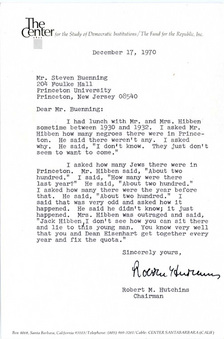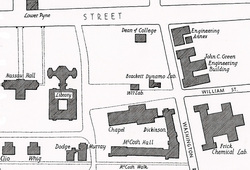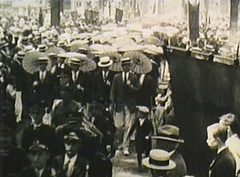Mudd Manuscript Library’s new exhibition features women at Princeton, from the days of Evelyn College (1887-1897), mainly attended by daughters of Princeton University and Princeton Theological Seminary professors, to the appointment of Shirley Tilghman as the first woman president of Princeton University in 2001. For the first time our exhibit is accompanied by historical film footage from the archives. This compilation of segments from films and videos, most of which was featured previously in The Reel Mudd, is shown here.
The footage covers forty years of history of Princeton women, from the admission of Sabra Meservey as the first woman at the Graduate School in 1961 to Shirley Tilghman’s presidency. Subjects covered include the introduction of coeduation, student activism and Sally Frank, and activities of the Women’s Center and SHARE (Sexual Harassment/Assault Advising, Resources, and Education).
The compilation opens with footage of the Class of 1939’s junior prom in 1938 (taken from its Class film), which was attended by 606 women (all listed by name in the Daily Prince). Women only entered academic life at Princeton in 1961, when Sabra Meservey was admitted at to the Graduate School. The footage at 0:37 shows Meservey’s humorous account of her initial conversation with President Robert Goheen, who ultimately oversaw the introduction of undergraduate coeducation in 1969, and wanted to use Meservey as a “test case” at the Graduate School. (For the full story, see the the blog about the Celebration of Coeducation at the Graduate School.)
The only filmed recollections about the early years of coeducation were found on the documentary Looking Back: Reflections of Black Princeton Alumni (1:32), created on the occasion of Princeton’s 250th anniversary in 1996. The changes on campus did not please everybody. In 1974 Princeton icon Frederick Fox ’39 reached out to disgruntled alumni in the film A Walk in the Springtime, pointing out, perhaps tongue in cheek, that Nassau Hall’s two bronze tigers were male and female (3:19). In the following fragment, taken from the short Academy award winning film Princeton, A Search For Answers (1973), women feature prominently (3:55).
The last fragments feature woman activism and the gains of the women’s movement of the 1970s and the 1980s. Two fragments were taken from the Class of 1986’s Video Yearbook: a speech from Sally Frank ’80, who sued the last three all-male eating clubs (4:18), and a Women’s Center sit-in in May 1, 1986 (4:45). The last two fragments have not been featured yet in The Reel Mudd but will be shortly. The first is a sketch from “Sex on a Saturday Night,” a theater performance for freshmen about sexual harassment, presented by SHARE (5:11), The film ends with the inauguration of Shirley Tilghman (5:11) in 2001, taken from the documentary “Robert F. Goheen ’40, *48; Reflections of a President” (2006).
The exhibit “She Flourishes:” Chapters in the History of Princeton Women may be visited during Mudd Library’s opening hours on weekdays between 9.00 am and 4.45 pm. from now until the end of August 2012.





